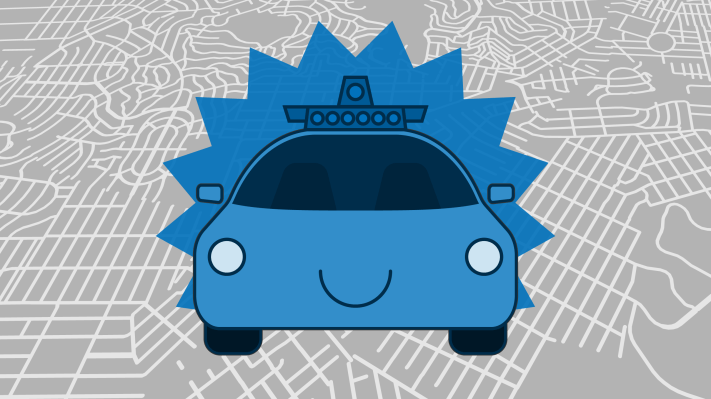On my daily jog the other day, with my daughter in a stroller and my dog in tow, I came to my usual stop at the crosswalk of a four-lane road without a light. Traffic moves quickly on this street, and cars typically don’t stop to allow us to cross unless I make direct eye contact with a driver. It usually takes a while to get the chance to cross.
But this day was different. A futuristic vehicle making its way down the street slowed to a controlled stop the moment I approached the edge of the street. It was my first brush with one of Google’s self-driving cars. Despite this car never having encountered my particular combination of dog, stroller and runner, it stopped as if it had seen me a thousand times before and knew my intent.
As I waved to the engineer inside and continued on my way, I started thinking about how the information and skills that self-driving vehicle systems must share represent compelling models and lessons that might be adapted to my own field — healthcare.
In healthcare, learning networks and sharing have always been underpinnings of the profession. Presently, efforts focus on developing what are called “Learning Health Systems” (LHS). These are representative efforts to innovate within a legacy structure, but often leverage antiquated communication and coordination tools to share learnings with other care professionals. Thus, they do not push the thinking far enough, nor leverage the technology of our time.
For instance, a recent article in a leading journal implied groundbreaking LHS impact for 130 patients. The report being discussed claimed cost reductions of nearly $10,000 per patient over a year, with improved outcomes when sharing decisions and communication were combined with entering standard data into an electronic health record (EHR). However, the effort required 20 support staff members for four physicians, and the overall costs of running the program outweighed the savings it delivered.
Furthermore, no one outside the core program participants or 130 patients immediately learns from what worked for this group unless they read a scientific article and then adapt and implement a similar program. Lessons were learned and care did improve, no doubt, but the scalability of this type of program is certainly an issue. Let’s contrast this to the self-driving car I encountered.
Since 2009, Google’s self-driving cars have clocked more than two million miles, largely on city streets, and accumulated the equivalent of 300 years of human driving experience. This is in addition to the one billion simulated miles accumulated in 2016 alone. Most importantly, they actually update in real time and communicate with each other via the cloud, allowing all cars to acquire new skills every time one car does.
The use of modern technology will drive higher-fidelity distributed learning if we facilitate collective intelligence.
Anyone with a driver’s license knows there is no replacement for time behind the wheel. If only we humans could share with each other the way these robot cars do — distributing an aggregate level of knowledge the moment a teenager sits down in the driver’s seat for the first time.
We can’t use this collective intelligence model to transform teenage brains, but can we apply it to our chronic disease burden to enhance clinical care and drive breakthroughs in delivery? I’m not suggesting robot doctors. Rather, the use of modern technology will drive higher-fidelity distributed learning if we facilitate collective intelligence like those autonomous vehicle systems. We can transform chronic disease treatment from the traditional episodic touch points to a continuous mix of synchronous and asynchronous communication, exploiting both virtual and face-to-face delivery and greater patient collaboration.
Distributed knowledge and sharing in real time allows disparate care providers to engage with cutting-edge insights and up-to-the-minute lessons, generating a whole much greater — and more responsive — than its parts. The care delivery model could be made to be self-driving.
Incentivizing a “sharing” care model for information and insights — to move and meld information between the small practice in Mississippi treating a hypertensive patient and a doctor at a state-of-the-art academic center in Arizona treating a similar case — requires an innovation model centered around the doctor and the patient, not around legacy equipment and proprietary systems.
As Google’s head of self-driving technology famously explained, they aren’t building a car, they are building a driver.
To be clear, I’m mulling disruption in the care delivery model and the way we share insight, not the practice of medicine in the U.S. as a whole. The brilliance of innovation at the forefront of U.S. healthcare is incredible. We’ve progressed the procedural side of medicine in ways that make self-driving cars seem like child’s play. From minimally invasive heart valve replacements to transplants of nearly every type of organ to cures for cancers and diseases that killed people less than 20 years ago, there is no doubt that the U.S. is the epicenter in health innovation.
Yet for diseases that aren’t of a “broken/fixed” nature — costly chronic diseases like diabetes, heart failure, hypertension — we have not seen equivalent advancements.
The technology that fuels autonomous vehicle development may serve us well by facilitating a new model and a new approach. By promoting the power of a collective view to incentivize new business models, leveraging a shared learning network of scalable tools and solutions centered on the doctor-patient relationship, there is a chance to have the innovations in healthcare delivery lap those I saw that morning at the crosswalk.
